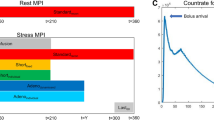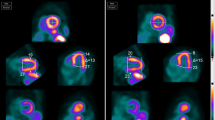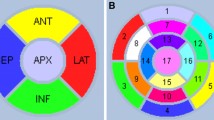Abstract
Purpose
This study was undertaken to determine if artifacts from misalignment of cardiac emission to transmission data is present in adenosine stress studies and if the artifact could be reproduced by intentional misalignment in normal exams.
Procedures
Seventy consecutive 82Rb myocardial perfusion studies were reviewed. Utilizing a quality control program, misalignment was assessed. The study was reprocessed after manual realignment to determine if the defect extent changed. Emission and transmission acquisitions in six normal studies also were intentionally misaligned.
Results
Twenty of 69 rest studies (29.0%) and 17 of 69 (24.6%) stress studies demonstrated misalignment. In four patients with stress misalignment, there was a significant change in clinical interpretation. Upon intentionally misaligning six normal studies, a lateral wall defect was reproduced.
Conclusions
Emission–transmission misalignment occurs in 29.0% and 24.6% of 82Rb rest and adenosine stress studies, respectively. While there is a positive correlation of artifactual defects with misalignment, the presence and size of artifacts is variable and unpredictable at seemingly lesser degrees of misalignment.



Similar content being viewed by others
References
Gould KL (1991) Clinical cardiac positron emission tomography: state of the art. Circulation 84:I22–I36
Gropler RJ, Soto P (2004) Recent advances in cardiac positron emission tomography in the clinical management of the cardiac patient. Curr Cardiol Rep 6:20–26
Marwick TH, Shan K, Patel S, Go RT, Lauer MS (1997) Incremental value of rubidium-82 positron emission tomography for prognostic assessment of known or suspected coronary artery disease. Am J Cardiol 80:865–870
DePuey EG, Garcia EV (1989) Optimal specificity of thallium-201 SPECT through recognition of imaging artifacts. J Nucl Med 30:441–449
Freedman N, Schechter D, Klein M, Marciano R, Rozenman Y, Chisin R (2000) SPECT attenuation artifacts in normal and overweight persons: insights from a retrospective comparison of Rb-82 positron emission tomography and TI-201 SPECT myocardial perfusion imaging. Clin Nucl Med 25:1019–1023
Bateman TM (2004) Cardiac positron emission tomography and the role of adenosine pharmacologic stress. Am J Cardiol 94:19D–24D, (discussion 24D–25D)
Loghin C, Sdringola S, Gould KL (2004) Common artifacts in PET myocardial perfusion images due to attenuation-emission misregistration: clinical significance, causes, and solutions. J Nucl Med 45:1029–1039
McCord ME, Bacharach SL, Bonow RO, Dilsizian V, Cuocolo A, Freedman N (1992) Misalignment between PET transmission and emission scans: its effect on myocardial imaging. J Nucl Med 33:1209–1214, (discussion 1214–1205)
Gould KL, Pan T, Loghin C, Johnson NP, Guha A, Sdringola S (2007) Frequent diagnostic errors in cardiac PET/CT due to misregistration of CT attenuation and emission PET images: a definitive analysis of causes, consequences, and corrections. J Nucl Med 48:1112–1121
Holmberg MJ, Mohiuddin SM, Hilleman DE, Lucas BD Jr, Wadibia EC (1997) Outcomes and costs of positron emission tomography: comparison of intravenous adenosine and intravenous dipyridamole. Clin Ther 19:570–581, (discussion 538–579)
Gupta NC, Esterbrooks D, Mohiuddin S et al (1991) Adenosine in myocardial perfusion imaging using positron emission tomography. Am Heart J 122:293–301, (discussion 302–296)
Siffring PA, Gupta NC, Mohiuddin SM et al (1989) Myocardial uptake and clearance of T1-201 in healthy subjects: comparison of adenosine-induced hyperemia and exercise stress. Radiology 173:769–774
Xu EZ, Mullani NA, Gould KL, Anderson WL (1991) A segmented attenuation correction for PET. J Nucl Med 32:161–165
Garcia EV, Cooke CD, Van Train KF et al (1990) Technical aspects of myocardial SPECT imaging with technetium-99 m sestamibi. Am J Cardiol 66:23E–31E
Faber TL, Cooke CD, Folks RD et al (1999) Left ventricular function and perfusion from gated SPECT perfusion images: an integrated method. J Nucl Med 40:650–659
Santana CA, Folks RD, Cooke CD, Faber TL, Garcia EV (2001) Rubidium-82 myocardial perfusion PET: development and validation of combined normal limits. J Nucl Cardiol 8(4):S134, (abstract)
Van Train KF, Areeda J, Garcia EV et al (1993) Quantitative same-day rest-stress technetium-99m-sestamibi SPECT: definition and validation of stress normal limits and criteria for abnormality. J Nucl Med 34:1494–1502
Chin BB, Nakamoto Y, Kraitchman DL, Marshall L, Wahl R (2003) PET-CT evaluation of 2-deoxy-2-[18F]fluoro-d-glucose myocardial uptake: effect of respiratory motion. Mol Imaging Biol 5:57–64
Schelbert HR, Beanlands R, Bengel F et al (2003) PET myocardial perfusion and glucose metabolism imaging: Part 2-Guidelines for interpretation and reporting. J Nucl Cardiol 10:557–571
Bettinardi V, Gilardi MC, Lucignani G et al (1993) A procedure for patient repositioning and compensation for misalignment between transmission and emission data in PET heart studies. J Nucl Med 34:137–142
Bacharach SL, Douglas MA, Carson RE et al (1993) Three-dimensional registration of cardiac positron emission tomography attenuation scans. J Nucl Med 34:311–321
Fricke H, Fricke E, Weise R, Kammeier A, Lindner O, Burchert W (2004) A method to remove artifacts in attenuation-corrected myocardial perfusion SPECT Introduced by misalignment between emission scan and CT-derived attenuation maps. J Nucl Med 45:1619–1625
Nye JA, Esteves F, Votaw JR (2007) Minimizing artifacts resulting from respiratory and cardiac motion by optimization of the transmission scan in cardiac PET/CT. Med Phys 34:1901–1906
Fitzpatrick GM, Wells RG (2006) Simulation study of respiratory-induced errors in cardiac positron emission tomography/computed tomography. Med Phys 33:2888–2895
Author information
Authors and Affiliations
Corresponding author
Rights and permissions
About this article
Cite this article
Schuster, D.M., Halkar, R.K., Esteves, F.P. et al. Investigation of Emission–Transmission Misalignment Artifacts on Rubidium-82 Cardiac PET with Adenosine Pharmacologic Stress. Mol Imaging Biol 10, 201–208 (2008). https://doi.org/10.1007/s11307-008-0139-2
Received:
Revised:
Accepted:
Published:
Issue Date:
DOI: https://doi.org/10.1007/s11307-008-0139-2




